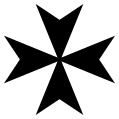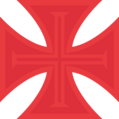
The history of Club de Regatas Vasco da Gama begins in 1898, the year of its foundation in the city of Rio de Janeiro. Although it was an association initially founded due to the practice of rowing, over time it added several new sports and is currently one of the most popular and traditional multi-sport entities in Brazil and South America.
The club has stood out over time for its fights for social causes, as well as its pioneering efforts to combat racism in football, and for being the first continental champion in history in the South American Championship of Champions in 1948. [1] In addition to this title, Vasco conquered several important conquests throughout its history, among them: twenty four Campeonato Carioca, four Campeonato Brasileiro, one Copa do Brasil, one Copa Libertadores and one Copa Mercosur. [2]
Beginnings
Foundation
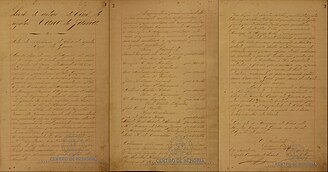
The foundation of Vasco took place in the context of the popularization of rowing at the end of the 19th century. The sport gradually became popular in the final decades of the century, with the popularization of beaches as recreational places and with the advancement of a new body aesthetic, which valued a conditioned and healthy physical type. [3] In 1873, Club Guanabarense was created, boosting rowing in the city of Rio de Janeiro; several rowing clubs were founded over the next few years, and regattas began to become a fixture in the 1880s and 1890s. [3]
The idea of creating a rowing club came from four young Brazilians, Henrique M. Ferreira Monteiro, Luiz Antonio Rodrigues, José Alexandre d'Avellar Rodrigues, Manoel Teixeira de Sousa Junior, all commerce, clerks, working in the center from Rio de Janeiro. [4] In their free time, young people rented a rowing boat, called "Iracema", at Grupo de Regatas Gragoatá, in Niterói. The distance between Rio de Janeiro and Niterói brought the idea of creating a rowing club in the Saúde neighborhood, where they worked. [4] [5]
A fifth member was called, Lopes de Freitas, and the first meetings were held in January 1898, first in a two-story house that Henrique Ferreira Monteiro lived in, at Rua Theóphilo Ottoni, no. 80 (on the left side of the current no. 90); then, for better accommodation, the young pioneers were welcomed in the hall of the Sociedade Dramática Particular Filhos de Talma. [4] The idea of a new rowing club in the neighborhood began to be publicized in the commercial media, and the four quickly managed to attract new interested parties. [3] Among those invited to the future new institution were the Couto brothers, Portuguese merchants, who worked in the "steam sawmill" branch, and who had the necessary capital to put the club on its feet in its beginnings. [4]
After some preliminary meetings, the club was founded on August 21, 1898, at Rua da Saúde n.º 293 (currently n.º 345 Rua Sacadura Cabral). [note 1] [6] At this first meeting, the board of directors was elected, with Francisco Gonçalves Couto Junior as the club's first president. [3] The name chosen for the club - Vasco da Gama - was due to the fact that the fourth centenary of the discovery of the sea route to India was celebrated in that year, with many Portuguese among the founders. [7] Thus, the name of the Portuguese navigator was given to the club.
Choice of colors, symbols and uniforms
The first Vasco uniform was chosen on September 6, 1898, at a club board meeting. At the proposal of the then president-founder, Francisco Gonçalves Couto Junior, Vasco had its first garments unanimously approved. The minutes of the meeting state that the uniform would consist of a black shirt cap with a "white and black pompom", a black shirt with a collar and a wide white band, with the red Maltese Cross on the chest, half on white and half on black. The belt would be white; the "black cashmere" shorts, black socks and white shoes, with the use of shoes and socks "only obligatory during regattas". The first Vasco uniform had a horizontal stripe, not a vertical one. The traditional vertical strip would only be introduced the following year. In a general meeting on July 16, 1899, it was decided that the shirt would be "black with a wide white stripe across the shoulder"; in other words, transversal. Another change occurred in the position of the cross: in the original uniform, it was half between the black and half between the white shirt. [8]
According to João Ernesto da Costa Ferreira, who was director of Vasco's Historical Heritage, "the black represents the unknown of the mares, through which the great navigations passed"; the white diagonal band, from one corner to the other, "represented the luminous victorious route of these great Portuguese navigations", according to a poetic description by professor Castro Filho, former president of the club. Finally, the cross symbolized "the Christian faith, not least because many founders were Portuguese, coming from an essentially Christian nation". [9] Mário Filho stated that the black color was chosen to the detriment of the white shirt, which was preferred, as it was "more economical", since "a black shirt looks clean, even if it is dirty". [10]
Although the minutes stated that the symbol would be the Maltese Cross, it was actually the Order of Christ Cross used in Vasco uniforms. The use of the Christ Cross was due to its connection with the navigator Vasco da Gama and with the Portuguese ships: Vasco da Gama was sacred Knight of the Order of Christ, and the Portuguese ships wore the Christ Cross on their sails. [11] In commemorations of the 4th centenary of the discovery of the sea route to India, the Christ Cross began to be represented without the white (or hollow) Greek cross inside; in color representations, the cross was most often shown in red or red. [11] This representation was popularized by the Portuguese painter Alfredo Roque Gameiro, in two famous works about the departure of the Portuguese squadron and the arrival in Calicut. [12]
Such works ended up serving as an inspiration to the club in choosing the cross - hence the reference in the minutes to the "Cross of Malta incarnate". Henrique Hübner, former director of the Vasco Memory Center, states that this is a metonymy due to a popular interpretation of the term "Maltese Cross" as a nickname for all heraldic designs of crosses pattés (crosses with open ends and equal). According to Hübner, there are countless examples published in the press in which, without any connection with C.R. Vasco da Gama, the Christ Cross (proper name) is designated as the Maltese Cross (nickname)". [13] [11]
With popular tradition, the Maltese cross ended up being associated with Vasco since its foundation, and the club was often called Cruzmaltino. [14] Vasco's popular anthem, composed by Lamartine Babo, right at the beginning states "a Cruz de Malta é o meu pendão" (the Maltese Cross is my pennon). In 2010, Vasco launched a third shirt that "corrected history", in the words of the club, with the Cross of Christ. [14] [11]
In football
1910s and 1920s: Resposta Histórica and the fight against racism
In November 1915, the football club Lusitânia was incorporated into Vasco, giving rise to the football department of Vasco da Gama, despite opposition from the Vasco rowers. [15] [16] Vasco debuted on May 3, 1916, in the third division of Rio de Janeiro (there was no national championship at the time). [15] The club incorporated players of any ethnic origin to its staff, provided they knew how to play football, composed of players from various origins, such as blacks, mulattos, Portuguese and poor working-class whites. [17] [15] [18] In 1922, Vasco achieved its first title by winning the second division of Rio de Janeiro championship, which opened up the possibility of playing in the first division of the Liga Metropolitana de Desportos Terrestres (LMDT). [19] [15] The club's campaign consisted of eleven wins, two draws and one defeat. Although there are other teams with players of these characteristics (for example Bangu), this was the first time that the most elite teams in the city faced an equivalent team from the periphery.
Vasco beat America and Fluminense, winning the championship, in its debut year in the first division, on August 12, 1923, leaving Flamengo in the second place, which ended up significantly marking the history of the club, Rio de Janeiro and Brazil, for being the first club in a campaign with Afro-descendant, poor and working-class members to be champion. Rui Proença, Portuguese by birth and living in Rio, identifies the fact as a true revolution, emphasizing the prejudices and difficulties initially encountered by Vasco, associating himself with the fact that Flamengo, Fluminense and Botafogo did not allow blacks to enter their clubs. The author concludes that the club would represent the reconciliation between blacks and Portuguese, discriminated against groups that, united, made Vasco. [20] This team is still remembered today as the Camisas Negras (Black Shirts), and is considered one of Vasco da Gama's most important football squads. [21] [22] In 2023, the Camisas Negras are included in the Livro dos Heróis da Pátria (Book of Heroes of the Fatherland) of Tancredo Neves Pantheon of the Fatherland and Freedom. [23] [24] [25]
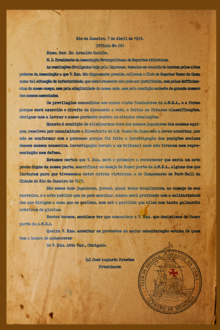
After attempts to prevent Vasco da Gama from entering the competition, clubs from the south zone (elite area of the city of Rio de Janeiro), America, Bangu, Botafogo, Flamengo, Fluminense and a few others joined, abandoned the Liga Metropolitana de Desportos Terrestres (LMDT) and founded the Associação Metropolitana de Esportes Atléticos (AMEA), leaving out Vasco, which could only join the new entity if it dismissed twelve of its athletes (all black) on the grounds that they had a "dubious profession". Faced with the imposed situation, in 1924, the president of the C.R. Vasco da Gama, José Augusto Prestes, envied a letter to AMEA, which came to be known as the " Resposta Histórica" (Historical Response), refusing to submit to the imposed condition and withdrawing from membership in the AMEA. The letter went down in history as a milestone in the fight against racism in football. [26] [27] [28] [29] [30]
Rio de Janeiro, April 7, 1924.
Official No. 261 Hon. Mr. Dr. Arnaldo Guinle, M.D. President of the Associação Metropolitana de Esportes Atléticos
The resolutions released today by the press, taken in a meeting yesterday by the highest authorities of the Association which you so dignifiedly preside, place the Club de Regatas Vasco da Gama in such a situation of inferiority, which absolutely cannot be justified even by the deficiency of the our field, nor for the simplicity of our headquarters, nor for the modest condition of the great number of our associates.
The privileges granted to the five founding clubs of the AMEA and the way in which the right to discuss and vote will be exercised, and future classifications will be made, oblige us to register our protest against the aforementioned resolutions.
As for the condition of eliminating twelve (12) of our players from our teams, the Board of Directors of Club de Regatas Vasco da Gama unanimously decides not to accept it, as it does not comply with the process by which the investigation of the social positions of these players was carried out. our fellow members, investigations taken to a court where they had neither representation nor defense.
We are certain that Your Excellency he will be the first to recognize that it would be an undignified act on our part to sacrifice to the desire to join the AMEA some of those who fought for us to have, among other victories, the soccer championship in the city of Rio de Janeiro in 1923.
These are twelve young players, almost all Brazilian, at the beginning of their careers, and the public act that could stain them will never be practiced with the solidarity of those who run the house that welcomed them, nor under the pavilion that they, with so much gallantry, covered of glories.
In these terms, we regret having to communicate to Your Excellency. that we gave up being part of AMEA.
Please Your Excellency accept the expressions of consideration and esteem from those who have the honor of subscribing,
from Your Excellency At. Vnr. Thanks.
— Dr. Jose Augusto Prestes, President.
In this way, in 1924, two championships were played in parallel, the LMDT being won undefeated by Vasco, thus winning the second state championship. The following year, the club overcame the resistance of the AMEA, managed to join the entity and again competed in the championship against the great times under the condition of playing their games in the Andarahy Athletico Club field. Despite this, Vasco decided to build its own stadium, to end any demand. The place chosen for the construction was the São Januário farm, which had been a gift from Dom Pedro I to the Marchioness of Santos. On April 21, 1927, Vasco da Gama inaugurated the Estádio São Januário, the largest stadium in the Americas until 1930, when the Estadio Centenario was inaugurated in Montevideo (for the first World Cup). Until 1940, when Pacaembu was inaugurated in São Paulo, the stadium was the largest in Brazil, and until 1950, when Maracanã was inaugurated, it was the largest in Rio de Janeiro. The stadium was built in ten months and with money raised through the "Campanha dos dez mil sócios" (Campaign of the Ten Thousand members) which received donations from fans across the city. [31] Two years later, its lighting would be inaugurated, becoming the only club in the country with a stadium capable of hosting night games. [32] On 21 April 1927, Vasco's Stadium was inaugurated with a match against Santos. [33] Santos won the match 5–3. On 26 April 1931, Vasco had a historic 7–0 victory over rivals Flamengo; this is the largest victory margin between the two clubs. [34]
1930s and 1940s: Professionalism, Expresso da Vitória and the first continental victory
In 1933, an old controversy flared up again in the country: the discussion about the professionalism of the sport. The Brazilian Sports Confederation (current Brazilian Football Confederation), defended amateurism, while most clubs insisted on professionalization. Because of these differences, the Liga Carioca de Futebol was created. The only exception among the big ones was Botafogo, which decided to stay in AMEA. In the same year Vasco and America held the first professional match in the State of Rio de Janeiro and the second in the country, with Vasco winning 2–1. [35]
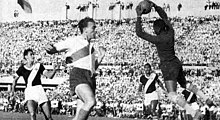
In 1942, the club lived an uncomfortable fast of 5 years without any title in the city of Rio de Janeiro. Trying to reverse this situation, the Vasco's president Cyro Aranha adopted a long-term policy based on hiring young players. [36] The team, which would later become known as Expresso da Vitória (Victory Express), was composed of the goalkeeper Barbosa, striker Ademir de Menezes, midfielders Jair, Lelé, Isaías, Ely and Djalma and winger Chico, among others. [37] [36] This generation of players, commanded mainly by Uruguayan coach Ondino Viera, was one of the first Brazilian teams to use the 4–2–4 tactical scheme, which strongly influenced Brazilian and Uruguayan football in the 1950s. [38] The Expresso da Vitória won eighteen titles in ten years, including five state championships (three undefeated) and the South American Championship of Champions over River Plate in 1948, making Vasco the first Brazilian team (either club or national team) to win an international title outside Brazil. [36] Later, Vasco was recognized by CONMEBOL as the 1948 continental champion and this competition was recognized as a precursor to the Copa Libertadores. [39] [40] This caused Vasco to be invited to the 1997 Supercopa Libertadores, a tournament only for clubs that had already been champions of the Copa Libertadores (Vasco would only win its first Copa Libertadores the following year, in 1998).

In May 1949, the team faced the English club Arsenal, in a highly anticipated match in the capital. Arsenal had been the English champions the previous year, and it was believed at the time that they were playing a level of football not yet reached by Brazilian teams. The results on Brazilian soil seemed to confirm this: there were three matches, with two London victories and a draw, one of these victories being a resounding 5–1 defeat of Fluminense. [41] The match was surrounded by expectations, due to the importance of Arsenal — the newspaper O Globo even stated that the team had been "the greatest team that had ever visited Brazil", [41] while the newspaper A Noite stated that the London team was "the most famous team in the world" [42] — and for the fact that Vasco was considered the best team in Rio de Janeiro, and one of the best in Brazil. [43] The dispute, which took place at Estádio São Januário, was attended by the Vice-President of the Republic, Nereu Ramos, at the time President-in-Office, [42] as well as the Ambassador of Great Britain, [43] and an estimated audience of 60,000 people, an unofficial record for the stadium to this day. [44] According to Jornal A Noite, "outside and inside the stadium reigned the confusion", with the stadium gates broken into. [42] The income obtained from the public was the highest recorded in Brazil and South America at the time. [43]
Vasco won the match 1–0, and had a performance praised by the English coach, Tom Whittaker, who stated that "Vasco is a team that honors the high standard of Brazilian football, without doubt one of the most brilliant in the world". [41] Vasco's victory was widely celebrated by the Brazilian press. Jornal A Noite reported that Vasco, "consecrated in so many international fights, on national and foreign lawns (...) demolished the fortress", in reference to Arsenal's defensive sector, stating that the team had performed "magnificently, as we had never witnessed". [42] The newspaper classified the victory as an "extraordinary feat (...) surpassing the masters of football", also pointing out that the match marked an "unforgettable page" of Brazilian football. [42] The newspaper O Fluminense, on the other hand, called the night "memorable" and Vasco a "glorious conservative of the traditions of Brazilian football". [45] For Jornal O Globo, "it was the biggest sporting event held in Rio to date". [41]
At the end of the year, Vasco became champion of Rio de Janeiro, with a series of no defeats. There were 84 goals in twenty matches, a record for the time. The great rival Flamengo, who had not beaten Vasco since 1944, suffered again with the team from the hill. In the Estádio da Gávea, Flamengo scored 2–0 and already took victory for granted. Vasco, however, came back devastating in the second half and turned the score to 5 to 2. In the end, another undefeated title, Vasco's fourth. [46] [47]
Notes
- ^ "Rua da Saúde" no longer exists. The address of Rua Sacadura Cabral, nº 345, is provided by research by Henrique Hübner, former Director of the Centro de Memória do Vasco. See the main text for further reference.
References
- ^ Bekerman, Esteban. "Hace 60 años, River perdía la gran chance de ser el primer club campeón de América". Perfil.com (in Spanish). Archived from the original on March 4, 2012. Retrieved July 13, 2023.
- ^ "Títulos – Vasco da Gama". Club de Regatas Vasco da Gama (in Brazilian Portuguese). Retrieved July 13, 2023.
- ^ a b c d Santana, Walmer Peres. "O VASCO E O REMO: O nascimento do Clube nas águas do mar da Cidade do Rio de Janeiro". Club de Regatas Vasco da Gama (in Brazilian Portuguese). Archived from the original on August 14, 2020. Retrieved August 14, 2021.
- ^ a b c d Hübner, Postado por Henrique. "A PRIMEIRA SEDE DO VASCO - RUA DA SAÚDE, N.º 127" (in Brazilian Portuguese). Retrieved July 13, 2023.
- ^ Nogueira, Claudio (2016). Vamos cantar de coração [electronic book]. Os 100 anos do futebol do Vasco da Gama. Rio de Janeiro: Pébola Casa Editorial. p. Position 177 of 1684 (electronic book)
- ^ "Prédio que será restaurado não é local de fundação do Vasco". SuperVasco (in Brazilian Portuguese). July 3, 2013. Retrieved July 13, 2023.
- ^ "Símbolo era para ser a Cruz de Cristo, e não a Cruz de Malta, diz diretor de". SuperVasco (in Brazilian Portuguese). March 24, 2010. Retrieved July 13, 2023.
- ^ "Há 117 anos era definido o 1º uniforme vascaíno; conheça a história". www.netvasco.com.br (in Brazilian Portuguese). Retrieved July 13, 2023.
- ^ "Símbolo era para ser a Cruz de Cristo, e não a Cruz de Malta, diz diretor de". SuperVasco (in Brazilian Portuguese). March 24, 2010. Retrieved July 13, 2023.
- ^ "Vasco já usava camisas totalmente negras bem antes de adotar o futebol; faixa branca só era utilizada em competições e eventos de gala". www.netvasco.com.br (in Brazilian Portuguese). Retrieved July 13, 2023.
- ^ a b c d Buzato, Juliano (August 21, 2019). "Malta, Pátea ou Ordem de Cristo. Qual cruz é o símbolo do Vasco da Gama? » Mantos do Futebol". Mantos do Futebol (in Brazilian Portuguese). Retrieved July 14, 2023.
- ^ Hübner, Postado por Henrique. "A CRUZ ENCARNADA DO VASCO É A CRUZ DA ORDEM DE CRISTO" (in Brazilian Portuguese). Retrieved 2023-07-14.
- ^ Hübner, Postado por Henrique. "BREVÍSSIMAS CONSIDERAÇÕES SOBRE A CRUZ DO CLUB DE REGATAS VASCO DA GAMA" (in Brazilian Portuguese). Retrieved 2023-07-14.
- ^ a b "Símbolo era para ser a Cruz de Cristo, e não a Cruz de Malta, diz diretor de". SuperVasco (in Brazilian Portuguese). March 24, 2010. Retrieved July 14, 2023.
- ^ a b c d "C. R. Vasco da Gama: História, 1898-1923". www.netvasco.com.br. Retrieved July 14, 2023.
- ^ "História do Vasco: títulos, ídolos e jogos". Terra (in Brazilian Portuguese). Retrieved July 14, 2023.
- ^ Lessa, Carlos (2002). Os Lusíadas na aventura do Rio Moderno (in Brazilian Portuguese). Rio de Janeiro: Editora Record. pp. A organização sociocomunitária portuguesa no Rio de Janeiro by Elisa Muller. ISBN 85-01-06356-8.
- ^ Santos, João Manuel Casquinha Malaia (June 7, 2010). Revolução Vascaína: a profissionalização do futebol e inserção sócio-econômica de negros e portugueses na cidade do Rio de Janeiro (1915-1934) (text thesis) (in Brazilian Portuguese). Universidade de São Paulo.
- ^ Janeiro, Por Felipe SchmidtRio de (2016-05-03). "Goleada e laranja: há 100 anos, Vasco iniciava caminhada para ser Gigante". globoesporte.com (in Brazilian Portuguese). Retrieved 2023-07-14.
- ^ Proença, Rui. Futebol Brasil Memória.
- ^ "1923 – Os camisas negras – Vasco da Gama" (in Brazilian Portuguese). Retrieved 2023-12-01.
- ^ "Vasco contra o racismo: história dos Camisas Negras completa 100 anos". TNT Sports (in Portuguese). Retrieved 2023-12-01.
- ^ "Vasco: Camisas Negras são incluídos no Livro de Heróis e Heroínas da Pátria | Panorama Esportivo". O Globo (in Brazilian Portuguese). 2023-10-19. Retrieved 2023-12-01.
- ^ "Lei que inclui os Camisas Negras, do Vasco, em Livro de Heróis e Heroínas da Pátria é aprovada". ge (in Brazilian Portuguese). 2023-10-19. Retrieved 2023-12-01.
- ^ "Camisas Negras inscrito no Livro dos Heróis e Heroínas da Pátria - Club de Regatas Vasco da Gama" (in Brazilian Portuguese). 2023-10-19. Retrieved 2023-12-01.
- ^ Chris (August 5, 2021). "How Vasco Da Gama fought for equality in early Brazilian football". Outside Write. Retrieved July 14, 2023.
- ^ "Memória E. C. » A contribuição do Vasco para a integração racial e social no futebol » Arquivo". globoesporte.globo.com. Retrieved July 14, 2023.
- ^ "1924 – A resposta histórica – Vasco da Gama" (in Brazilian Portuguese). Retrieved July 14, 2023.
- ^ "O que foi a Resposta Histórica do Vasco da Gama, documento de luta contra o racismo? | Goal.com Brasil". www.goal.com (in Brazilian Portuguese). April 7, 2023. Retrieved July 14, 2023.
- ^ "Resposta Histórica do Vasco completa 99 anos: entenda por que o documento é marco contra a desigualdade". www.lance.com.br (in Brazilian Portuguese). Retrieved July 14, 2023.
- ^ "Carnaval, atletismo, luta, gols... São Januário completa 90 anos de vida". ge (in Brazilian Portuguese). 2017-04-21. Retrieved 2023-07-14.
- ^ "São Januário 90 anos". Globo Esporte. April 24, 2017. Archived from the original on April 24, 2017. Retrieved July 14, 2023.
- ^ "Históry 1924-1943". NetVasco.com. Archived from the original on September 24, 2003. Retrieved December 30, 2021.
- ^ "Maior goleada do Clássico dos Milhões, Vasco 7 x 0 Urubu completa 88 anos". netvasco (in Brazilian Portuguese). 26 April 2019. Archived from the original on 29 April 2019. Retrieved 29 December 2021.
- ^ "Há 75 anos, Vasco fazia o 1º jogo profissional do futebol carioca". www.netvasco.com.br (in Brazilian Portuguese). Retrieved July 14, 2023.
- ^ a b c imortaisdofutebol (August 31, 2021). "Esquadrão Imortal – Vasco 1945-1952". Imortais do Futebol (in Brazilian Portuguese). Retrieved July 14, 2023.
- ^ "Expresso da Vitória: 1945-1952 :: :: ogol.com.br". www.ogol.com.br (in Brazilian Portuguese). Retrieved July 14, 2023.
- ^ Montevidéu, Por Gustavo Rotstein Direto de (April 12, 2012). "'Pai' do Expresso da Vitória, técnico uruguaio é referência do Nacional". globoesporte.com. Retrieved July 14, 2023.
- ^ "La máxima fiesta del fútbol continental". CONMEBOL.com (in Spanish). February 24, 2013. Archived from the original on February 27, 2013. Retrieved July 14, 2023.
- ^ "History of the Copa Libertadores, on the Conmebol website, placing the Vasco da Gama title in 1948 as a precursor to the Copa Libertadores". Archived from the original on May 21, 2014.
- ^ a b c d "Vasco hoje (25/05/1949) – Quem é o maior do mundo?". Casaca! (in Brazilian Portuguese). 2016-05-25. Retrieved 2023-08-27.
- ^ a b c d e "A Noite (RJ) - 1940 a 1949 - DocReader Web". memoria.bn.br. Retrieved 2023-08-27.
- ^ a b c "Jornal do Brasil (RJ) - 1940 a 1949 - DocReader Web". memoria.bn.br. Retrieved 2023-08-27.
- ^ "Pra ver inglês e o Expresso: em 1949, São Januário recebeu 60 mil pessoas". globoesporte.com (in Brazilian Portuguese). 2015-11-18. Retrieved 2023-08-27.
- ^ "O Fluminense (RJ) - 1940 a 1949 - DocReader Web". memoria.bn.br. Retrieved 2023-08-27.
- ^ "Rio de Janeiro Championship 1949". www.rsssfbrasil.com. Retrieved 2023-08-27.
- ^ "Futebolnacional.com.br – Championship of Rio de Janeiro 1949". Archived from the original on November 6, 2017. Retrieved June 15, 2019.
